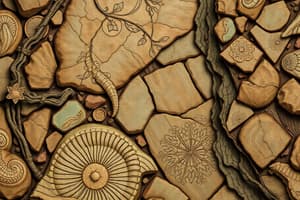Podcast
Questions and Answers
What is the primary way sedimentary rock is formed?
What is the primary way sedimentary rock is formed?
- From the erosion of existing rocks
- From the compression of sand or mud over time (correct)
- From the decomposition of plant material
- From the cooling of molten lava
What can be inferred from the presence of aquatic fossils in an area that is now dry land?
What can be inferred from the presence of aquatic fossils in an area that is now dry land?
- The area was once covered by water (correct)
- The area has always been dry land
- The area is prone to flooding
- The area is a habitat for aquatic life
Why are fossils of organisms that existed for a short period of time useful for establishing the age of rock?
Why are fossils of organisms that existed for a short period of time useful for establishing the age of rock?
- Because they are always well-preserved
- Because they are common in all rock layers
- Because they are found in only the oldest rock layers
- Because they are found in many different places (correct)
What can be learned from studying fossils in different rock layers?
What can be learned from studying fossils in different rock layers?
What can be inferred from the presence of fossils of complex organisms in a particular rock layer?
What can be inferred from the presence of fossils of complex organisms in a particular rock layer?
What can scientists learn from studying fossils in a particular area?
What can scientists learn from studying fossils in a particular area?
Flashcards are hidden until you start studying
Study Notes
Formation of Sedimentary Rock
- Sedimentary rock forms from mud or sand, which can cover dead animals or plants, eventually pressing them into stone.
- Over time, layers of sand or mud accumulate, and the pressure transforms them into rock.
Fossils and Age of Rocks
- Fossils provide clues about the age of the surrounding rocks.
- Fossils in lower layers are distinct from modern organisms, while those in upper layers are more similar to contemporary species.
- Fossils also show an increase in complexity as you move up the rock layers.
Fossils and Environment
- Fossils of organisms that existed briefly and in many places are useful for establishing the age of rocks.
- The type of fossil found in an area can reveal information about the past environment, such as food sources and lifestyle.
- Fossilized remains can indicate that an area was once different from its current state (e.g., the Petrified Forest in a desert or aquatic fossils in areas far from the sea).
Forces and Change
- Dirt, mud, and sediment are initially deposited in horizontal layers, but they can be altered by external forces.
- Earthquakes and tectonic plate movement can cause rock layers to change, resulting in tilting or shifting of entire layers over millions of years.
Studying That Suits You
Use AI to generate personalized quizzes and flashcards to suit your learning preferences.




